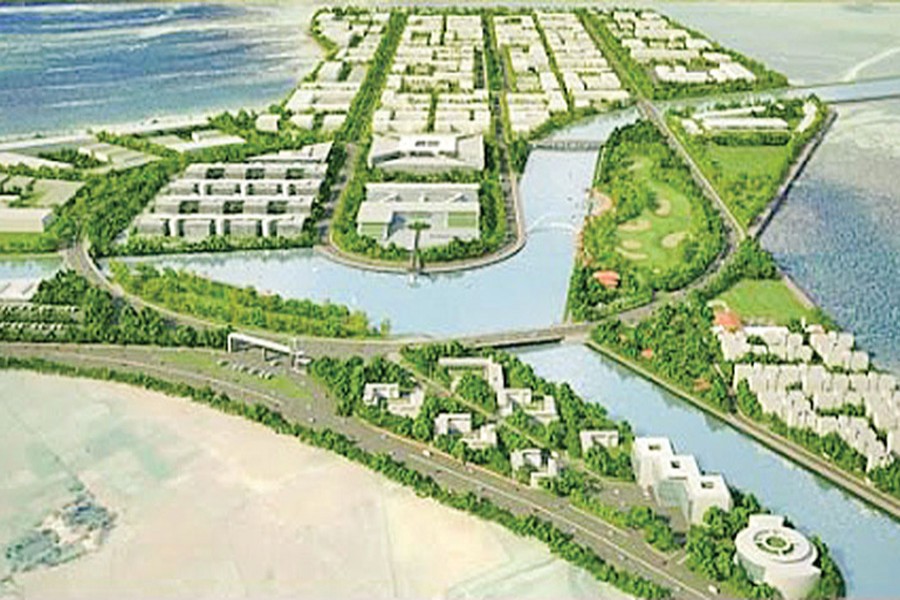The government's initiative to develop country-specific special economic zones (SEZs) has so far made little headway, thus impeding efforts to help attract sizeable foreign investments.
Though the Bangladesh Economic Zones Authority (BEZA) has already allotted substantial land under G2G (government-to-government) arrangement, factors like non-availability of soft loans and lengthy process to select the developers have slowed down the progress, people familiar with the situation said.
Notwithstanding the setbacks, foreign investors' interest has been rising gradually, demonstrating the emerging importance of the country's strategic and geographical location.
The BEZA has selected four SEZs -- Araihazar in Narayanganj and Anwara in Chattogram, Mongla in Khulna and Bheramara in Kushtia for Japanese, Chinese and Indian investors respectively. Of the four, Mongla and Bheramara special economic zones (SEZs) are exclusively for Indians.
The country-focused SEZs will be built in an arrangement where Bangladesh government will have 30 per cent equity and foreign investors the rest.
After visits to some of the zones, the FE correspondents, however, found no notable progress in development of the SEZs.
In most cases, the authorities could not finish the initial tasks such as the selection of the international developer and land acquisition process. Only Chinese SEZ completed the steps.
Though the zones authority handed over 778 acres of land to the Chinese developer China Harbour Engineering Company Ltd., in Anwara more than a year ago, the latter could finish the work for one half of two approach roads and has now started erecting the boundary wall to the site.
BEZA executive chairman Paban Chowdhury said the authorities had selected four country-specific SEZs on the G2G basis with 30 per cent government equity.
He said that they have received investment proposals worth $17 billion until now, of which overseas investors share stood at $8.0 billion.
"It's not just a proposal because the interested investors are also required to deposit one per cent of the proposed investment in accordance with our requirement," he said.
When asked about the slow progress of development work at the Anwara zone, he said that the authorities have handed over the site to a Chinese developer who is yet to manage funds from the Chinese government.
"But I've been told that there has been progress in getting the Chinese fund. I think it will be accelerated soon," he added.
On the other hand, the BEZA has just started the land acquisition process for the Araihazar SEZ, which is being developed on 1,000 acres of land for Japanese companies while two Indian developers have been shortlisted for the job.
BEZA manager Saleh Ahmed, who is assigned to oversee the Araihazar SEZ, said that the authorities and the Japanese developer are "advancing professionally' to finish the land acquisition process. "I hope, we'll be able to complete the process by June next."
The BEZA official said that China, which has scaled up outbound investment as part as its Belt and Road Initiative (BRI), topped the list of overseas investors with securing 2,878 acres followed by India (1,400 acres), Japan (1,000 acres), Singapore (100 acres) and Australia (20 acres).
Due to the growing demand for industrial space from China, the BEZA has kept 1,100 acres in Mirsarai while the Chinese steel giant Kunming Iron and Steel Holding Company (KISC) sought another 1,000 acres for setting up its plant. This excludes the Anwara SEZ.
The BEZA has decided, in principle, to provide them with the land at the Moheskhali economic zone.
Indian investors will get 1,000 acres in Mirsarai, 300 acres and 100 acres in Bheramara and Mongla SEZs respectively while Singapore-based Wilmar Group will get 100 acres in Mirsarai where an Australian company also booked 20 acres.
When contacted, Li Guangjun, economic and commercial counsellor at the Chinese Embassy in Dhaka, citied two reasons behind the slow progress in the industrial park in terms of developing industrial units and offshore infrastructure.
Terming the zone a joint venture project of the BEZA and China Harbour Engineering Company Ltd, he said the Chinese firm would invest in developing the park and both parties were engaged in reaching a development agreement.
"First of all, the agreement will contain lots of information. That's why, it is taking time. But hopefully, it will be finalised or signed in the next two to three months," he said.
Secondly, Mr. Li said offshore infrastructure will be another part that is supposed to be funded by the Chinese government. "On that part, the Chinese government is still negotiating and consulting with Bangladesh government. I think China will definitely support this project."
He also noted that Chinese government encourages the private sector to invest in many potential sectors in Bangladesh, geographically located on the 21st century maritime Silk Road.
The BEZA with a vision for becoming a world-class investment promoter wants to build 100 economic zones across the country by 2030 with the principle of creating a cluster of industries in a planned way to better utilise the land, which is scarce.
The BEZA is developing such industrial spaces in three categories- PPP (public private partnership), G2G and privately-owned ones, being synchronized with the UN's sustainable development goals (SDGs), by 2030.
The government's latest five-year plan has a target of attracting $9.56 billion foreign investment in 2020 and special zones are a key part of the policy-mix aimed at reaching this objective.
Zones are also estimated to boost the country's export earnings by $40 billion and generate employment for around 10 million.


